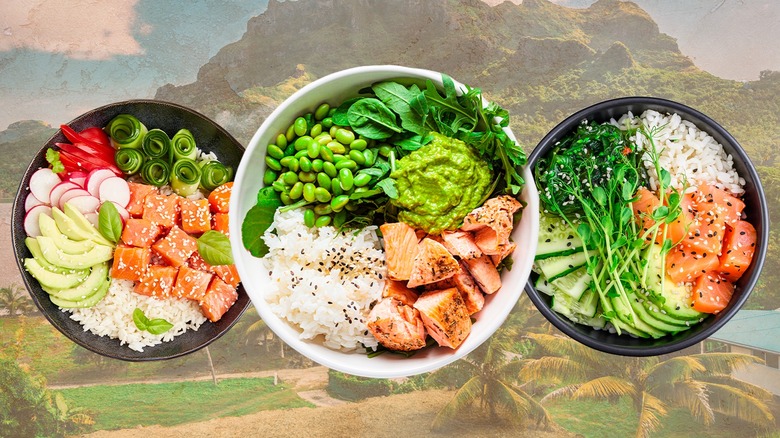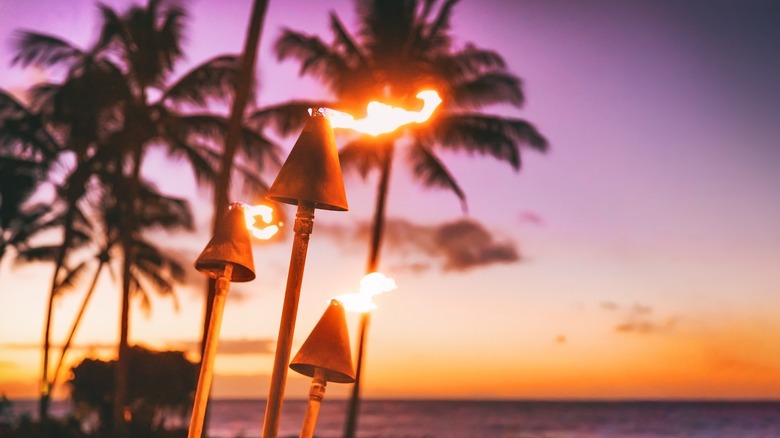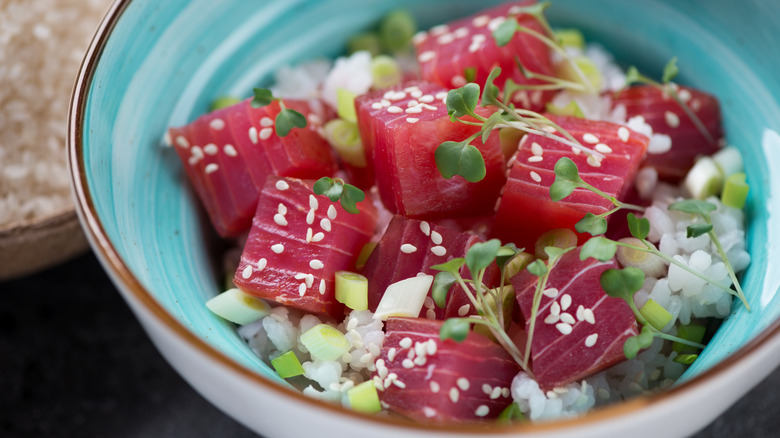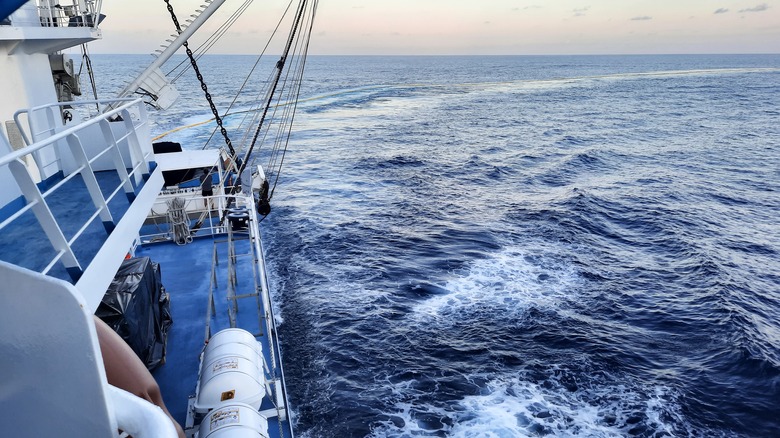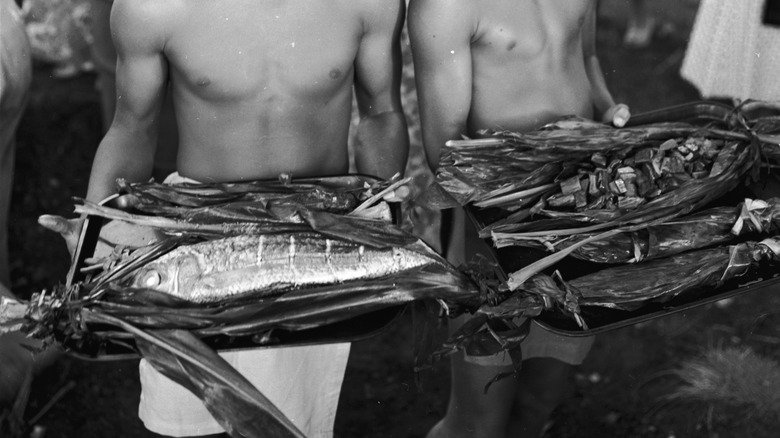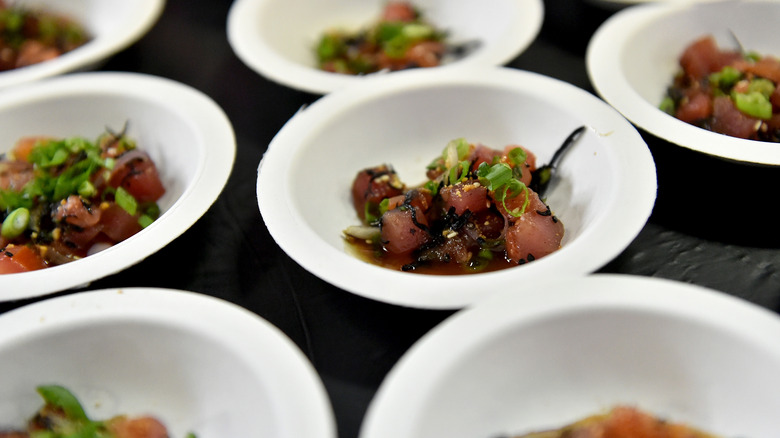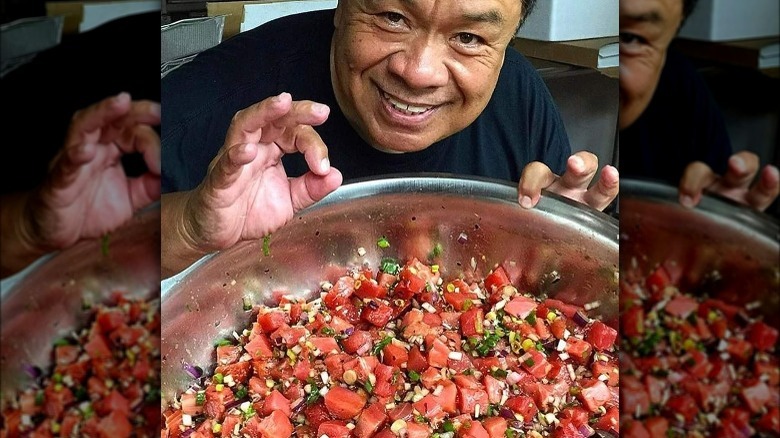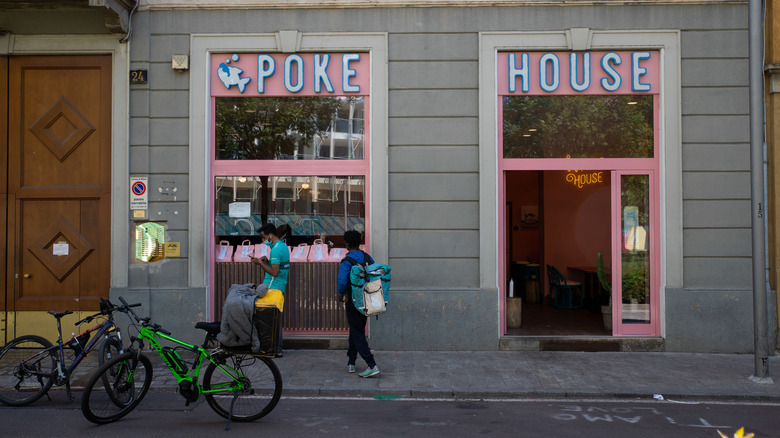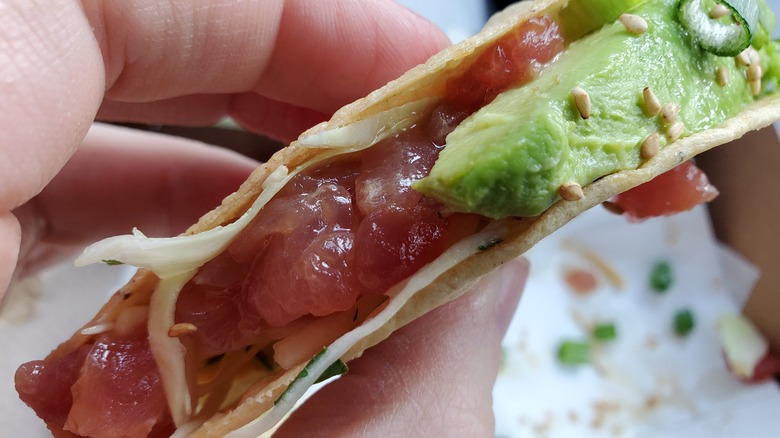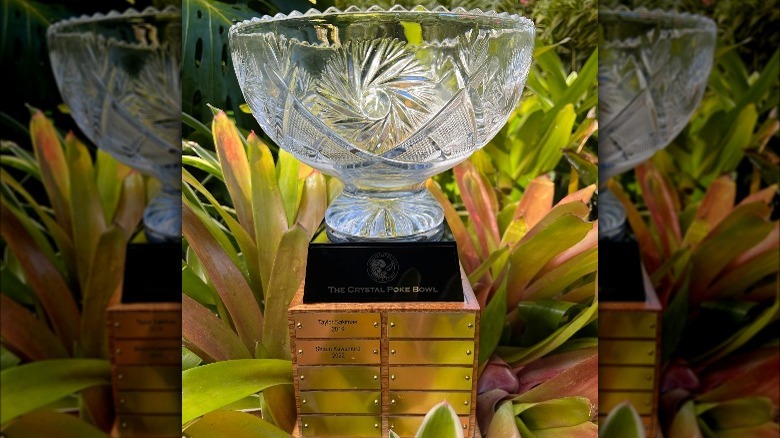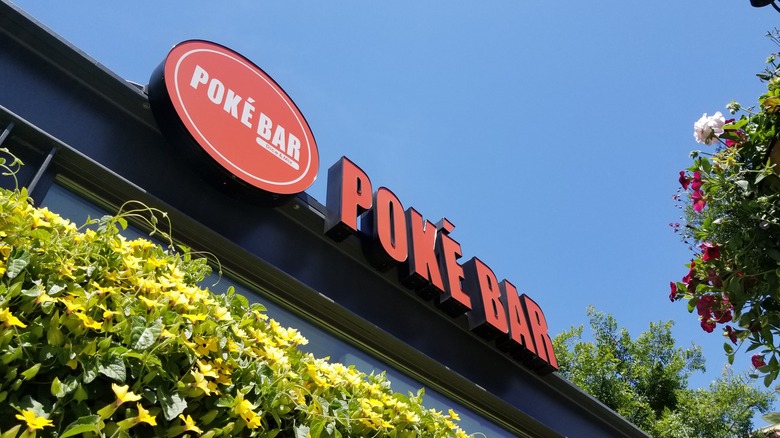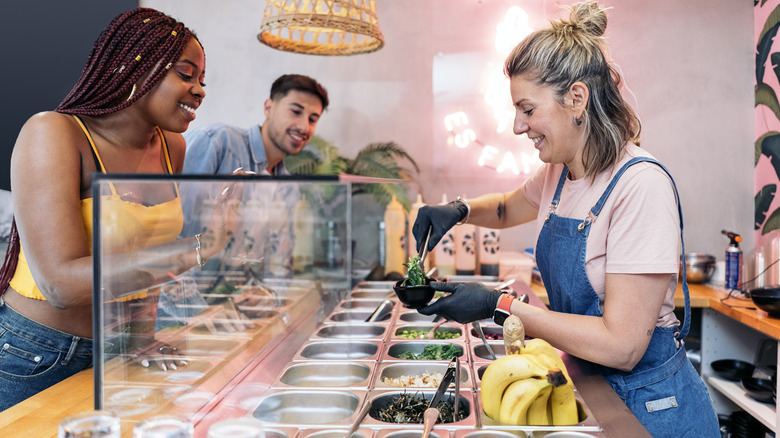The Ancient Polynesian Origins Of Poke Bowls
One of the biggest food trends worldwide in recent years has been the poke bowl. In 2019, Money called poke "the next fast-casual restaurant phenomenon," and it shows no signs of slowing down. As of 2023, more than one in 50 U.S. restaurants serve poke bowls — and the global market is expected to keep growing by 8.41% annually through 2026 (via Technavio). This seafood dish isn't just showing up at specialty eateries, either. International restaurant chains like The Cheesecake Factory and Red Lobster have jumped headfirst into poke bowls and their ever-increasing variations.
But poke — which is pronounced "poh-kay", like "okay" — is more than just a food fad. The origins of this traditional dish date back long before the 21st-century landscape of make-your-own poke bowls and poke nachos. And like many dishes that are now in the mainstream, it started as a much simpler dish. To learn the roots of the poke bowl, we must venture away from the mainland and back in time to the islands of Polynesia. As you'll see, poke has come a long way from its roots — and there's a lot of debate over whether that's good or bad.
The poke bowl's story goes back centuries
The origins of the poke bowl begin among the native Polynesians who migrated to the Hawaiian Islands sometime between 500 and 1500. Fishing was (and still is) a major food source in the Pacific islands. In what is now Hawaii, the fishermen would sometimes chop up and season the raw cut-offs from the day's catches — which are the pieces left over after cutting fillet portions — and serve them raw for a snack or appetizer. The word "poke" is often translated as "to cut crosswise into pieces" in the region's Polynesian dialect, though the dish wasn't known by this name at the time.
Regardless, it was a quick and easy way to enjoy fresh fish, and a less-refined version of sashimi. Salt was a common seasoning, both for flavor and as a preservative. Other seasonings included limu (seaweed); ogo (algae); and inamona, a condiment made of kukui nuts that are roasted, crushed, and salted. This traditional version can still be found today — typically under the name Hawaiian poke or limu poke.
It underwent a cultural evolution in the late 19th century
Even before the recent poke trend, the dish had undergone some changes thanks to new influences. For starters, there was the immigration of Japanese workers and their descendants, who first came to Hawaii in the late 19th century as sugar and pineapple plantation laborers. Japan has its own rich cultural connection to fish — though consumption has waned in recent years, the average Japanese adult still ate 23.2 kilograms of seafood in 2021, which equals 51.1 pounds (via Statista).
These immigrants brought their taste for raw fish with them to Hawaii along with their unique methods of preparing it. They introduced donburi, a traditional raw fish and rice alternative to sushi; this is purportedly what led to white rice becoming an accepted poke base. And instead of using salt and seaweed to season their raw fish chucks, Japanese transplants would use shoyu (soy sauce) and sesame oil.
Both additions would become indelible aspects of modern poke that also made it more popular among islanders. And it wasn't the only cultural addition. After Westerners reached the Hawaiian islands and were introduced to poke, they added some spice with onions and chili peppers. The result was a mishmash of Polynesian, Asian, and Western cuisine that reflected the islands' increasingly diverse population.
New fishing vessels also changed poke
It wasn't just the things being added to the raw fish that changed poke — it was the type of fish itself. While there was some deep-sea fishing in ancient Polynesian times, reef fish — also known as inshore fish — were the most reliable seafood option for Hawaiian fishermen. Using methods that ranged from basket traps to bone hooks, they would haul in these small, bony creatures, with the cut-offs being turned into poke.
However, when American and British fleets of whaling boats began sailing Hawaiian waters in the early 19th century, it marked the dawn of large-scale fishing in the region. The arrival of the Japanese also greatly increased the appetite for deep-sea catches. Longline boats eventually allowed Hawaiians and Japanese immigrants to fish from Midway Island to the Palmyra Atoll. And with this expanded reach came greater accessibility to ahi tuna, which in Hawaii can refer to both yellowfin and bigeye tuna.
The combination of factors caused the price of tuna to fall more than 90%, from $3 per pound to 27 cents. As such, ahi quickly became the fresh fish of choice by Hawaiians and replaced reef fish as the raw seafood used for poke. Nowadays, ahi poke is the most popular type of poke in Hawaii — so much so that some publications refer to it as the traditional version. As noted by Hawaii Magazine, ahi shoyu poke is like getting the short version of Hawaii's history in food form.
It's one more expression of Hawaii's love for fish
However, it's seasoned or whatever type of seafood you use — some Hawaiian markets even serve tako poke made with octopus — poke has become an indelible part of the region's culture. It's not surprising given Hawaii has long been a fishing haven, whether for commercial anglers, recreation, or subsistence eating. Going back to ancient times, seafood was the primary source of protein for Hawaii's residents. Even in contemporary times, fish is a daily dietary staple for many on the islands. From 2000 to 2009, the average Hawaiian ate nearly 37 edible pounds of seafood per year — more than double the rest of the U.S. (via University of Hawaii at Manoa). This included 12.72 pounds of tuna annually, which is three times that of salmon, the No. 2 ranked fish.
Hawaiians prepare that fish in every which way. From dried and salted to grilled, baked, and fried varieties, they've come up with countless ways to enjoy fish. Yet poke is often considered their most notable contribution. This is even more interesting when you consider that both the largest study ever of Hawaiian fishing and the original Hawaiian ethnic cookbook don't contain a single mention of poke.
It's not clear exactly how the modern poke bowl first emerged
So how did the poke bowl become such an indelible symbol of Hawaii? Unfortunately, solid information in this area is somewhat scarce. Many sources say it got the name "poke" sometime in the 1960s or 70s, which is around the time its popularity started to grow beyond Hawaii. The first cookbooks containing poke recipes came out in the mid-70s.
Why did this growth happen? One theory is that it was spurred by the migration of Hawaiians to the mainland. There were three major 20th-century migration waves: one after World War II, one after Hawaii became a state in 1959, and one in the 1970s due to the increased cost of living on the islands. The final two waves correspond to the accepted period of when poke's rise began. Another proposed theory is that the popularity was aided by advanced deep-sea fishing techniques that led to ahi tuna being even more widely available.
But at this point, theories appear to be all we have. Nobody seems to know who started calling the dish "poke" or when. It's not clear when people went from simply seasoning poke fish to marinating it as is now commonplace. Publications can't even agree on the translation of the word "poke," with variations that include "something cut away," "cut into pieces," "to slice or cut," or simply "chunk." For a dish that has become so ubiquitous, it's fair to say there's a hazy section in its timeline.
Sam Choy helped ignite poke's popularity
There is one thing we can say for sure about the rise of the poke bowl — it wouldn't be where it is today without Sam Choy. The award-winning chef, who was born and raised on the Hawaiian island of Oahu, is known for good reason as the "Godfather of Poke." He was introduced to poke in the early 60s and was immediately fascinated with the dish, later telling Honolulu magazine, "Right at that moment, I knew that this was my love."
Choy carried that passion while developing his career as a chef. Then in 1991, three major events happened to help ignite poke's growth. First, Choy opened his first restaurant that year in Kona — and has since added several more throughout Hawaii and the Pacific Northwest. In August 1991, he was one of 12 chefs that created the Hawaii Regional Cuisine movement that emphasized local ingredients and dishes.
And finally, Choy organized his first poke cooking contest, which gave both professionals and enthusiasts a chance to showcase their takes on this native Hawaiian cuisine. These contests are still held every year, and the added visibility quickly led to Hawaiian fine-dining chefs like Alan Wong putting poke bowls on their menu. Choy himself eventually opened a restaurant and food truck, Sam Choy's Poke, devoted almost exclusively to the dish.
Poke restaurants have been booming for a decade
We alluded to this at the beginning, but if you want poke nowadays, it isn't hard to find. In the beginning, poke restaurants sprung up in areas where there were relatively large amounts of Hawaiian transplants. Notably, San Mateo, California's Takahashi Market — which is still open today — began serving Hawaiian cuisine such as poke in the late-1950s for transplants working at the nearby San Francisco airport.
But in the 21st century, poke bowls and Hawaiian fare, in general, are spreading like wildfire. In 2021, IBISWorld said there were 2,426 poke shops in the U.S. with a $1 billion market size. There are even a growing number of poke chains, with Pokeworks leading the charge at 63 locations as of 2022.
Where does the poke bowl go from here? As noted earlier, the global poke market is expected to continue growing through at least 2026. And while restaurants are springing up overseas, Technavio predicts 71% of that growth will come from North America. With restaurants now in places like Minnesota and Vermont that are about as far from the Hawaiian tropics as you can get, the poke bowl seems here to stay.
You can find modern poke in many forms
As the number of poke restaurants has grown, so have the ways you can eat it. Indeed, some forms of modern poke show little resemblance to the Polynesian original. You can get poke smothered in sauces and toppings. Instead of the rice base the Japanese introduced, some people put it on kale or zoodles. You can get poke wraps, tacos, and tostadas. Some eateries have introduced build-your-own poke bars like you'd find at Chipotle and other burrito joints.
This last part seems oddly appropriate. In fact, the effect of poke bowls going fast-casual resembles what happened when burritos and other cultural foods joined the culinary mainstream. Just like a chain-restaurant burrito isn't necessarily authentic Mexican fare, "fast food" poke doesn't always represent traditional poke. As Hawaiian chef and TV personality Lee Anne Wong bluntly puts it in an interview with Eater, "What you see across the country has been adapted for the American palette."
In a great irony, these increasing variations appear to have started in poke's homeland. Hawaii Magazine points out that Kalihi-based Tamashiro Market was among the first places to offer different types of poke.
There are now multiple poke festivals
Want to really celebrate your love for poke bowls — or want a fun way to experience them for the first time? Just find a poke festival. Just like there have long been festivals for barbecue, pizza, cheese, beer, and other favorite foods, poke festivals have joined the fray. Tracing their roots to the original poke contests hosted by Sam Choy, these festivals have started popping up in Hawaii and along the West Coast. In 2023, Bali Hai Restaurant of San Diego, California, hosted the 12th annual I Love Poke Festival. Featuring more than 25 chefs and restaurants from the San Diego area, the event honors all Hawaiian-inspired food and culture with competitions, tastings, music, and more.
You'll also find multiple poke festivals on the Hawaiian Islands. In recent years, Sam Choy has started hosting the Kauai Poke Fest at Koloa Landing Resort. It's been named the country's fourth-best specialty food festival by USA Today — and the competition's winning recipe will be added to the Holoholo Grill menu. Islanders also can check out the Frolic Hawaii Poke Fest at Ka Makana Ali'i, which is on its sixth edition in 2023. With many other Hawaiian cuisine events held worldwide, such as the multi-weekend Hawaii Food & Wine Festival every October, there are plenty of chances to try out the many types of poke bowls.
Some Hawaiians aren't crazy about the poke bowl trend
Poke has undeniably gone from an ancient regional dish to one that's bordering on commonplace. However, its newfound popularity hasn't exactly been welcomed with open arms by Hawaiian chefs and natives. Mark Noguchi tells First We Feast that, while he appreciates the spotlight on Hawaiian food, he thinks people who don't respect poke's origins shouldn't be making it. He also expressed disgust with how some people add an accent to the e or change the name to "poki," comparing it to changing the spelling of someone else's last name because you personally can't pronounce it.
On a related note, the spate of poke restaurants owned by people who aren't from Hawaii has raised questions of cultural appropriation. This reared its ugly head in 2018 when it came to light that Midwest-based chain Aloha Poke Co. had issued cease-and-desist notices to other poke restaurants that had "Aloha" in the name (via Washington Post). The backlash that followed had some comparing their actions to the colonizers who took over the Hawaii Islands in the 19th century.
Finally, there's the matter of the food itself. Maui-based head chef MiJin Kang Toride told Today that she never gets poke when she's on the mainland. Why? It's partially because all the customization and options make ordering it a hassle. More importantly, she simply doesn't think most mainland restaurants do justice to how fresh traditional poke tastes.
But others think the exposure can be a good thing
It's worth saying that not every native Hawaiian cringes at the site of a fast-casual poke shop. In an interview with the Washington City Paper, Maui-born chef Tiffany MacIsaac has noted many types of seafood are used to make poke on the islands, including salmon, mussels, and shrimp. In that sense, mainland alternatives don't seem so extreme. She also recognized there wouldn't be a market for poke without some of the changes and adaptations, and that regardless, it's nice to be able to enjoy poke even when you're far from home.
We also need to consider the complicated history of Hawaiian cuisine. Many foods Hawaii is known for, like Spam musubi and katsu, are themselves a result of cultural mixing. And as we wrote about earlier, poke had been influenced by Japan and the West long before the current phenomenon. Since immigrants shared their culinary traditions with the islands and created a fusion of styles, they argue, why not in turn share poke and use it to educate others about Hawaiian culture?
Regardless of your position on the modern poke craze, the dish has come a long way from its Polynesian roots. We think that as long as people are still making traditional poke and teaching its origins, those roots can remain the foundation for its growth.
